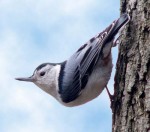 Everybody loves nuthatches! And why not? Their habit of running up and down trees at various angles captivates the eye of those who see them; they will come to your feeder for suet and big meaty seeds at all times of the year providing good entertainment for bird watchers, You might see one hacking away at a nut to get at the meat but it may fly to a tree and either hide the seed in the bark or hack it open there. They also find insects in tree bark and get the ones that other birds like wood peckers don’t see. Most insect eating birds view the insects in bark from an upright position but nuthatches walk upside down and see them from a different angle so they can get the insects the other birds missed. They have very strong legs and feet and can hang upside down from twigs and branches. You may see them in the company of titmice and chickadees.
Everybody loves nuthatches! And why not? Their habit of running up and down trees at various angles captivates the eye of those who see them; they will come to your feeder for suet and big meaty seeds at all times of the year providing good entertainment for bird watchers, You might see one hacking away at a nut to get at the meat but it may fly to a tree and either hide the seed in the bark or hack it open there. They also find insects in tree bark and get the ones that other birds like wood peckers don’t see. Most insect eating birds view the insects in bark from an upright position but nuthatches walk upside down and see them from a different angle so they can get the insects the other birds missed. They have very strong legs and feet and can hang upside down from twigs and branches. You may see them in the company of titmice and chickadees.
Size and Shape: Four inches long; stocky; large head, short tail, powerful bill, strong legs and fee.
Color: Blue-gray upper parts with white and reddish/chestnut underparts; throat white; face white with black eye stripe; black cap. Females generally have a narrower black back band, duller upper parts, and buffer underparts and may be difficult to distinguish from the males.
Song/Communication: There are several calls include kri in times of stress, qui, qui, qui during mating, and a rapid nit between pairs.
Habitat: Woodlands of deciduous trees.
Range: Across most of United States and southern Canada; south into western Mexico.
Nesting: A male’s courtship ritual includes bowing to the female, swaying back and forth with wings drooping and tail spread, and feeding her. The monogamous pairs find natural cavities in trees or holes abandon by woodpeckers. They may use a bluebird box. They add soft materials such as fur, shredded bark, and grass to the nest and may also smear dead insects at the entrance to protect the nests from squirrels that compete with them for the holes. The female lays 5-9 creamy white eggs with brown specks, that she incubates for about 2 weeks while the male feeds her. Both parents feed the hatched chicks until they fledge, about 18-16 days, and then an additional 14 days after fledging.
Feeding: Insects on trunks and branches of trees; stored nuts such as acorns and hickory in winter.
Backyard Tips: Provide suet and large nuts such as sunflower seeds and peanuts in winter. Encourage woodland for long term habitat improvement that will provide nuthatches with nesting sites as well as provide food in summer.
Comments: There are nine subspecies that differ mainly in the color of their plumage.
